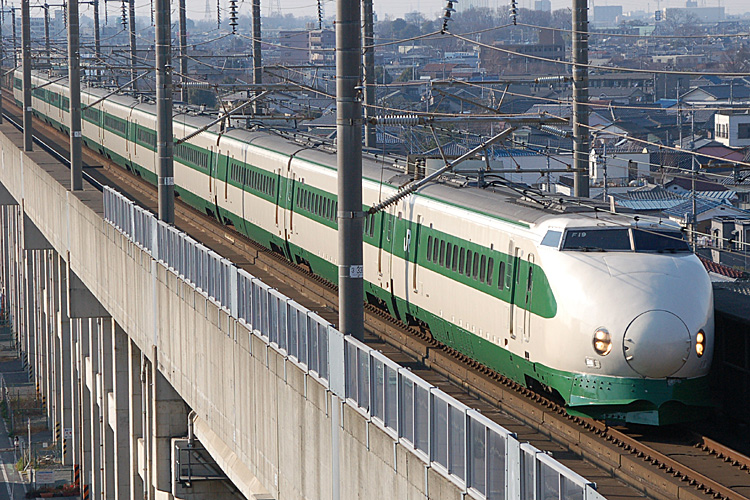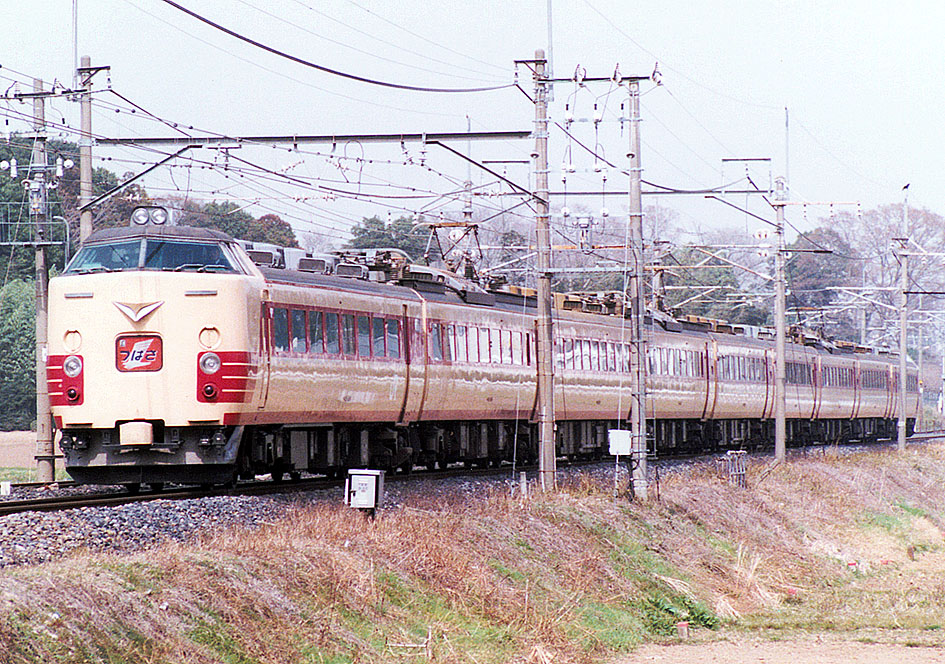|
200 Series Shinkansen
The was a Shinkansen high-speed train type introduced by Japanese National Railways (JNR) for the Tohoku Shinkansen and Joetsu Shinkansen high-speed rail lines in Japan, and operated by East Japan Railway Company (JR East) until 2013. They actually predated the 100 series trains, having been built between 1980 and 1986. It was one of the two recipients of the 23rd Laurel Prize presented by the Japan Railfan Club, the first Shinkansen type to receive that award. The last remaining sets were retired from regular service in March 2013, and were completely withdrawn from service in April 2013. Design The 200 Series Shinkansen trains resembled the earlier 0 series trains in styling (some later units had the pointed 'shark nose' of the 100 series), but were lighter and more powerful, since these two lines are mountain routes and have steeper gradients. These lines are also prone to snowfall and the trains had small snowplows fitted, as well as protection of equipment against snow ... [...More Info...] [...Related Items...] OR: [Wikipedia] [Google] [Baidu] |
Hitachi
() is a Japanese multinational conglomerate corporation headquartered in Chiyoda, Tokyo, Japan. It is the parent company of the Hitachi Group (''Hitachi Gurūpu'') and had formed part of the Nissan ''zaibatsu'' and later DKB Group and Fuyo Group of companies before DKB and Fuji Bank (the core Fuyo Group company) merged into the Mizuho Financial Group. As of 2020, Hitachi conducts business ranging from IT, including AI, the Internet of Things, and big data, to infrastructure. Hitachi is listed on the Tokyo Stock Exchange and Nagoya Stock Exchange and its Tokyo listing is a constituent of the Nikkei 225 and TOPIX Core30 indices. It is ranked 38th in the 2012 Fortune Global 500 and 129th in the 2012 Forbes Global 2000. History Hitachi was founded in 1910 by electrical engineer Namihei Odaira (1874–1951) in Ibaraki Prefecture. The company's first product was Japan's first induction motor, initially developed for use in copper mining. The company began as an in-house ven ... [...More Info...] [...Related Items...] OR: [Wikipedia] [Google] [Baidu] |
Shinkansen
The , colloquially known in English as the bullet train, is a network of high-speed railway lines in Japan. Initially, it was built to connect distant Japanese regions with Tokyo, the capital, to aid economic growth and development. Beyond long-distance travel, some sections around the largest metropolitan areas are used as a commuter rail network. It is operated by five Japan Railways Group companies. Over the Shinkansen's 50-plus-year history, carrying over 10 billion passengers, there has been not a single passenger fatality or injury on board due to derailments or collisions. Starting with the Tokaido Shinkansen () in 1964, the network has expanded to currently consist of of lines with maximum speeds of , of Mini-Shinkansen lines with a maximum speed of , and of spur lines with Shinkansen services. The network presently links most major cities on the islands of Honshu and Kyushu, and Hakodate on northern island of Hokkaido, with an extension to Sapporo under const ... [...More Info...] [...Related Items...] OR: [Wikipedia] [Google] [Baidu] |
Komachi (train)
The is a high-speed shinkansen service between and in Japan, operated by the East Japan Railway Company (JR East) since March 1997. It is the only shinkansen service that runs on the Akita Shinkansen, and uses E6 series trains. Between Tokyo Station and , it couples with Tōhoku Shinkansen E5 series '' Hayabusa'' and formerly E2 series for E3 series respectively. After Morioka, the ''Komachi'' service continues along standard gauge tracks that were converted from narrow gauge. Because it then runs on tracks that have grade crossings, its maximum speed from Morioka to Akita is , compared to on the Tohoku Shinkansen. The ''Komachi'' service was named after a famous poet from the area, Ono no Komachi, whose name (小町) is also synonymous with "belle" or "beauty" in Japanese. Station stops ''Komachi'' services stop at the following stations on the Akita Shinkansen between Morioka and Akita.JR Timetable, March 2013 issue For details of station stops between Tokyo ... [...More Info...] [...Related Items...] OR: [Wikipedia] [Google] [Baidu] |
Tsubasa (train)
The is a high-speed Shinkansen train service operated on the Yamagata Shinkansen by East Japan Railway Company (JR East) since July 1992. The name was formerly used for a limited express service operated by Japanese National Railways (JNR) and later by JR East, which ran from Ueno to Akita, and was discontinued in 1992 when the new shinkansen service commenced. The Japanese word "tsubasa" means "wing". Service outline The services were originally operated by 7-car 400 series trains, later replaced by 7-car E3 series trains. They couple with E2 series trains for their journey from Tokyo to Fukushima, travelling at a maximum speed of . ''Tsubasa'' trains are limited to on the Yamagata Shinkansen from Fukushima to Shinjō since there are many sharp curves and level crossings, as the line is essentially a regauged narrow-gauge line. Train formations ''Tsubasa'' services are operated by 7-car E3 series trainsets, with car 11 at the Tokyo end. All seats are no-smoking.JR Timet ... [...More Info...] [...Related Items...] OR: [Wikipedia] [Google] [Baidu] |
Yamagata Shinkansen
The is a Mini-shinkansen route in Japan, operated by East Japan Railway Company (JR East). It provides service between Tokyo and Shinjō in Yamagata Prefecture over the tracks of the Tohoku Shinkansen and the Ōu Main Line. The term Yamagata Shinkansen refers to the segment that connects Fukushima and Shinjō. Because the shinkansen trains share tracks with regular service trains, it is often referred to as a "mini-shinkansen". Operations Trains consist of 7-car E3 series trainsets operating as '' Tsubasa'' services. Between and Fukushima, the trains run coupled to '' Yamabiko'' trains on the Tōhoku Shinkansen. Between Fukushima and Shinjō, the trains run on their own at a maximum speed of and share the line with regular Ōu Main Line trains. As of July 2012, about 62 million passengers had ridden the line since it opened in July 1992. The fastest trains connected Tokyo and Yamagata stations in two hours and 29 minutes. Proposed Ou Base Tunnel Construction of a Ba ... [...More Info...] [...Related Items...] OR: [Wikipedia] [Google] [Baidu] |
Railway Coupling
A coupling (or a coupler) is a mechanism typically placed at each end of a rolling stock, railway vehicle that connects them together to form a train. A variety of coupler types have been developed over the course of railway history. Key issues in their design include strength, reliability, ease of making connections and operator safety. The equipment that connects the couplings to the vehicles is the draft gear or draw gear and these must absorb the stresses of coupling and train acceleration. Nomenclature Compatible and similar couplings or couplers are frequently referred to using widely differing make, brand, or regional names, or nicknames, which can make describing standard or typical designs confusing. Dimensions and ratings noted in these articles are usually of nominal or typical components and systems, though standards and practices also vary widely with railway, region, and era. Buffers and chain The basic type of coupling on railways following the British trad ... [...More Info...] [...Related Items...] OR: [Wikipedia] [Google] [Baidu] |
Snowplow
A snowplow (also snow plow, snowplough or snow plough) is a device intended for mounting on a vehicle, used for removing snow and ice from outdoor surfaces, typically those serving transportation purposes. Although this term is often used to refer to vehicles mounting such devices, more accurately they are known as winter service vehicles, especially in areas that regularly receive large amounts of snow every year, or in specific environments such as airfields. In other cases, pickup trucks and front end loaders are outfitted with attachments to fulfill this purpose. Some regions that do not frequently see snow may use graders to remove compacted snow and ice off the streets. Snowplows can also be mounted on rail cars or locomotives to clear railway tracks. Usage A snowplow works by using a blade to push snow to the side to clear it from a surface. Modern plows may include technology to make it easier to perform the work and stay on the road. These include Global Positionin ... [...More Info...] [...Related Items...] OR: [Wikipedia] [Google] [Baidu] |
Laurel Prize
The is an award presented annually in Japan since 1961 by the Japan Railfan Club. It is awarded for railway vehicles that entered service in the previous year and voted by the selection committee as having the most outstanding functional and design features. Award winners The list of award winners since 1961 is as follows. See also * List of motor vehicle awards * Blue Ribbon Award (railway) The is an award presented annually in Japan since 1958 by the . It is awarded for railway vehicles that entered service in the previous year and were voted by members as being the most outstanding design of the year. Award winners The ... References External links * {{in lang, ja The Blue Ribbon & Laurel Prize: Japan's Best New Trains, Japan Railway Journal on NHK World-Japan Awards established in 1961 Railway culture in Japan Commercial vehicle awards Japanese awards Rail transport industry awards ... [...More Info...] [...Related Items...] OR: [Wikipedia] [Google] [Baidu] |
100 Series Shinkansen
The was a Japanese Shinkansen high-speed train type which operated between 1985 and 2012 on the Tokaido Shinkansen and Sanyo Shinkansen high-speed lines. They were introduced after the 200 series trains, but their numbering is such because in the days of Japanese National Railways (JNR), Shinkansen types running east of Tokyo were given even numbers and those west of Tokyo odd numbers, hence they were given the next odd number in line after 0, 100. The last remaining examples of the type were withdrawn from service following the last runs on 16 March 2012. Design They differed visibly from the earlier 0 series in that the nose profile was more pointed. Another less obvious difference with the 16-car sets was that not all the cars were powered; the driving cars on each end were unpowered, as were the two bi-level centre cars. Some later production sets had powered driving cars and four unpowered bi-level trailers in the middle instead. The bi-level trailer cars contained a c ... [...More Info...] [...Related Items...] OR: [Wikipedia] [Google] [Baidu] |
East Japan Railway Company
The is a major passenger railway company in Japan and is the largest of the seven Japan Railways Group companies. The company name is officially abbreviated as JR-EAST or JR East in English, and as in Japanese. The company's headquarters are in Yoyogi, Shibuya, Tokyo, and next to the Shinjuku Station. It is listed in the Tokyo Stock Exchange (it formerly had secondary listings in the Nagoya and Osaka stock exchanges), is a constituent of the TOPIX Large70 index, and is also one of the three only Japan Railways Group constituents of the Nikkei 225 index, the other being JR Central and JR West. History JR East was incorporated on 1 April 1987 after being spun off from the government-run Japanese National Railways (JNR). The spin-off was nominally "privatization", as the company was actually a wholly owned subsidiary of the government-owned JNR Settlement Corporation for several years, and was not completely sold to the public until 2002. Following the breakup, JR ... [...More Info...] [...Related Items...] OR: [Wikipedia] [Google] [Baidu] |






.jpg)